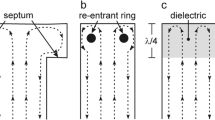Abstract
The Gordon coupler was introduced for use in EPR experiments at liquid helium temperatures. It provides an evanescent wave incident on the iris of a microwave resonator. Match of power incident on the coupler to the resonator is obtained by variation of the amplitude of an evanescent wave that arises from displacement of a dielectric wedge in a tapered waveguide. Reduced microphonics from helium bubbling was reported. The Gordon coupler was subsequently extended from cavity resonators to loop-gap resonators, initially at helium temperatures but later for aqueous samples. Plastics with low dielectric constants, usually Teflon, were used. Here, we extend the Gordon coupler for application in X-band five-loop–four-gap resonators using fused quartz, sapphire, or rutile dielectrics, noting that the size of the coupler can then be commensurate with dimensions of dielectric loop-gap resonators as well as dielectric tube resonators. Finite-element modeling of electromagnetic fields has been carried out, and use of a capacitive iris that interfaces with the Gordon coupler reduces pulling of the resonant frequency when matching the resonator.



Similar content being viewed by others
References
J.P. Gordon, Variable coupling reflection cavity for microwave spectroscopy. Rev. Sci. Instrum. 32, 658–661 (1961)
R.A. Isaacson, Microwave coupler for EPR cavities at 1.3 K. Rev. Sci. Instrum. 47, 973–974 (1976)
W. Berlinger, High-temperature EPR cavity for application of uniaxial stress. Rev. Sci. Instrum. 53, 338–341 (1982)
W. Froncisz, J.S. Hyde, The loop-gap resonator: a new microwave lumped circuit ESR sample structure. J. Magn. Reson. 47, 515–521 (1982)
R.D. Britt, M.P. Klein, A versatile loop-gap resonator probe for low-temperature electron spin-echo studies. J. Magn. Reson. 74, 535–540 (1987)
Y. Ohba, C. Watanabe, S. Nakazawa, S. Yamauchi, Determination of quality factor for highly overcoupled EPR resonators. Appl. Magn. Reson. 37, 781–794 (2010)
T. Ichikawa, H. Yoshida, J. Westerling, Coupling structure for the loop-gap resonator. J. Magn. Reson. 85, 132–136 (1989)
R. Gallay, J.J. van der Klink, Resonator and coupling structure for spin-echo ESR. J. Phys. E Sci. Instrum. 19, 226–230 (1986)
R.L. Wood, W. Froncisz, J.S. Hyde, The loop-gap resonator. II. Controlled return flux three-loop, two-gap microwave resonators for ENDOR and ESR spectroscopy. J. Magn. Reson. 58, 243–253 (1984)
T. Oles, J.S. Hyde, W. Froncisz, Gordon coupler for K-band EPR loop gap resonator. Rev. Sci. Instrum. 60, 389–391 (1989)
J.W. Sidabras, R.R. Mett, W. Froncisz, T.G. Camenisch, J.R. Anderson, J.S. Hyde, Multipurpose EPR loop-gap resonator and cylindrical TE011 cavity for aqueous samples at 94 GHz. Rev. Sci. Instrum. 78, 034701 (2007)
R.R. Mett, J.W. Sidabras, J.R. Anderson, C.S. Klug, J.S. Hyde, Rutile dielectric loop-gap resonator for X-band EPR spectroscopy of small aqueous samples. J. Magn. Reson. 307, 106585 (2019)
R.R. Mett, J.W. Sidabras, J.S. Hyde, Coupling of waveguide and resonator by inductive and capacitive irises for EPR spectroscopy. Appl. Magn. Reson. 35, 285–318 (2008)
M.E. Tobar, J. Krupka, E.N. Ivanov, R.A. Woode, Anisotropic complex permittivity measurements of mono-crystalline rutile between 10 and 300 K. J. Appl. Phys. 83, 1604–1609 (1998)
J. Krupka, K. Derzakowski, M. Tobar, J. Hartnett, R.G. Geyer, Complex permittivity of some ultralow loss dielectric crystals at cryogenic temperatures. Meas. Sci. Technol. 10, 3887–4392 (1999)
S. Ramo, J.R. Whinnery, T. Van Duzer, Fields and Waves in Communication Electronics (Wiley, New York, 1965)
F.E. Goodwin, G.E. Moss, Broad-band impedance matching into dielectric-filled waveguides. IEEE Trans. Microw. Theory Tech. 11, 36–39 (1963). https://doi.org/10.1109/TMTT.1963.1125588
F. Sporleder, H.-G. Unger, in Waveguide Tapers, Transitions, and Couplers, IEE Electromagnetic Waves Series Vol. 6. ed. by J.R. Wait, G. Millington, E.D.R. Searman (IEE, London, 1979)
R.R. Mett, J.W. Sidabras, J.R. Anderson, J.S. Hyde, Hyperbolic-cosine waveguide tapers and oversize rectangular waveguide for reduced broadband insertion loss in W-band electron paramagnetic resonance spectroscopy. Rev. Sci. Instrum. 82, 074704 (2011)
R.R. Mett, W. Froncisz, J.S. Hyde, Axially uniform resonant cavity modes for potential use in electron paramagnetic resonance spectroscopy. Rev. Sci. Instrum. 72, 4188–4200 (2001)
J.R. Anderson, R.R. Mett, J.S. Hyde, Cavities with axially uniform field for use in electron paramagnetic resonance. II. Free space generalization. Rev. Sci. Instrum. 73, 3027–3037 (2002)
J.S. Hyde, R.R. Mett, J.R. Anderson, Cavities with axially uniform fields for use in electron paramagnetic resonance. III. Re-entrant geometries. Rev. Sci. Instrum. 73, 4003–4009 (2002)
R.R. Mett, J.W. Sidabras, J.S. Hyde, Uniform RF fields in loop-gap resonators for EPR spectroscopy. Appl. Magn. Reson. 31, 573–589 (2007)
Acknowledgements
It is a pleasure to dedicate this paper to Professors Klaus Moebius and Kev M. Salikhov. The careers of James S. Hyde and the honorees have continued to overlap in many ways for more than fifty years as their interests shifted gradually from physics to biophysics. Research reported in this publication was supported in part by the National Institute of General Medical Sciences of the National Institutes of Health under Award number R01GM140385. The content is solely the responsibility of the authors and does not necessarily represent the official views of the National Institutes of Health.
Author information
Authors and Affiliations
Corresponding author
Additional information
Publisher's Note
Springer Nature remains neutral with regard to jurisdictional claims in published maps and institutional affiliations.
Rights and permissions
About this article
Cite this article
Mett, R.R., Hyde, J.S. Gordon Coupler with Inductive or Capacitive Iris for Small EPR Resonators for Aqueous Samples. Appl Magn Reson 53, 1265–1274 (2022). https://doi.org/10.1007/s00723-021-01432-0
Received:
Revised:
Accepted:
Published:
Issue Date:
DOI: https://doi.org/10.1007/s00723-021-01432-0




